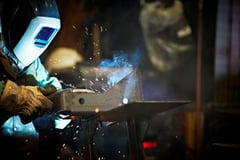Many manufacturing facilities use welding and hot work in their operations. Hot work includes welding, cutting, brazing and soldering, and grinding. Welding workstations can be a serious fire hazard if not set up and used properly. On average, more than 4,500 structure fires, resulting in about $480 million in property damage are started each year due to hot work. Employers that use hot work in their operations must develop a hot work safety program and ensure that welding workstations are set up as safely as possible. This will reduce the fire hazard and keep employees who perform these duties safe. 
Hot work program
An important risk management technique for manufacturing facilities is to create and use a hot work program. The program should clearly outline safety procedures for hot work and detail who’s responsible for certain safety tasks. It should also include areas of the building that aren’t acceptable for hot work and what personal protective equipment hot work operators should use. We have a sample hot work program that was developed by our loss control experts. Simply download the file and fill in your organization’s information.
Welding workstations
A key part of hot work safety is ensuring that every welding workstation is set up properly and safely. Read through our safety summary which includes many tips for welding workstations, such as the workstation should:
- Be free of combustible materials.
- Have a non-combustible worktable or fixture.
- Have non-flammable flooring.
- Provide a safe atmosphere with no flammable gases, vapors, liquids, or dust in the air.
- Provide proper ventilation and include protection for other workers.
- Have properly maintained welding equipment and personal protective equipment.
By implementing a hot work program and maintaining safe welding workstations, facilities can reduce their risk of fire and employee injuries.





